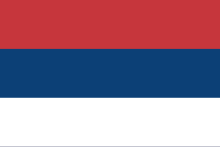Serbs in German-speaking countries
Many people with Serbian roots live in the German-speaking diaspora .
history
The first migration of Serbs in the German-speaking diaspora begins in the middle of the 19th century. Before and during the First World War , some Serbs studied at universities in Germany, Austria and Switzerland.
The second wave of migration by the Serbs took place after the coup by Alexander I. On January 6, 1929, he suspended the 1921 constitution, dissolved parliament and proclaimed the royal dictatorship . In the interwar period, many Serbs, as well as Croats and Slovenes , who were oppressed or found themselves in an economically hopeless situation, fled to the West.
In the second half of the 20th century, many Serbs went to Western Europe as guest workers (mainly to Germany , Austria and Switzerland ), largely due to difficult economic living conditions . There were also some emigrants who left Yugoslavia for political reasons. This migration made it possible for the then communist Yugoslavia to reduce unemployment and at the same time created enormous foreign currency income through the remittances of the emigrants to their families . Initially, there was no provision for workers to stay in the countries permanently. In the meantime, women and children have followed suit, and some Serbs are already the third or fourth generation to live here.
Yugoslav wars and escape from home
The last wave of emigration came with the disintegration of Yugoslavia (1991–1995), when Serbs left the country because of the newly erupted ethnic conflicts, the civil war, but also because of the catastrophic economic situation. During the Bosnian War (1992–1995), the Croatian War ( 1991–1995) and the Kosovo War (1998–1999), Serbs also fled the war .
Serbs in Germany
The first Serbs to live in Germany came here in the 1960s and 1970s as immigrants looking for work or guest workers from Yugoslavia. Most Serbs came to Germany as refugees during the Yugoslav wars (from 1991 to 2001). For 2014 the Federal Statistical Office published the number of 220,908 nationals in Germany. But there are significantly more Serbs living in Germany. The largest Serbian communities are in Stuttgart and Munich .
Serbs in Austria
The first Serbs settled in Vienna as early as the imperial era, for example in Magdalenengrund in the 18th century . Serbs immigrated in large numbers in the 1960s, 1970s and 1980s as so-called guest workers . Most Serbs came when the Yugoslav Wars (1991-2001) began. Serbs in Austria form part of the Serbian diaspora in Austria and, along with the Germans, are the largest migrant group in the country. The exact number of ethnic Serbs in Austria is not known, since the censuses only ask about nationality and mother tongue and not about ethnicity. According to the Austrian census in 2001, 177,320 people had Serbian citizenship at that time. The most important cities of the Serbs in Austria are Vienna , Graz , Salzburg and Feldkirch .
Serbs in Switzerland
The first big wave of emigration came in the 1960s to 1980s due to the need for guest workers , the second followed with the break-up of Yugoslavia in 1991 and the crises that followed. So far, no statistics have been collected in Switzerland on how many people are ethnic Serbs and where they come from. Based on the census, there are 103,350 people with Serbian citizenship. The most important centers of the Serbs in Switzerland are Zurich , Winterthur , St. Gallen and Lucerne .
religion
The Serbs are mainly Serbian Orthodox .
Well-known Serbs in German-speaking countries
- Dušan Vasiljević (* 1982), football player
- Dejan Ilic (* 1957), natural scientist and manager
- Anica Dobra (born 1963), actress
- Andrej Ćilerdžić (* 1961), Bishop of the Serbian Orthodox Diocese of Austria-Switzerland-Italy
- Gojko Mitić (* 1940), actor and director
- Milena Preradovic (* 1962), journalist and presenter
- Mladen Krstajić (* 1974), football player
- Svetislav Pešić (* 1949), basketball coach and former player
- Nikola Sarić (* 1985), painter
- Alen Stevanović (* 1991), football player
- Dušan Đurić (* 1984), football player
- Ivan Ergić (* 1981), football player
- Ana Ivanović (* 1987), tennis player
- Zdravko Kuzmanović (* 1987), football player
- Mileva Marić (1875–1948), physicist
- Svetozar Marković (1846–1875), publicist, politician and first Serbian socialist
- Veroljub Salatić (* 1985), football player
- Svaba Ortak (* 1992), rapper and hip-hop musician
Web links
- http://www.serbinfo.ch/
- http://www.zajednica-srba.ch/
- http://www.zentralrat-der-serben.at/
- http://vienna.mfa.gov.rs/
- http://www.zentralrat-der-serben.de/index.php?de
Individual evidence
- ↑ 2001 population by colloquial language, nationality and country of birth. In: statistik.at. Retrieved June 16, 2020 .
- ^ Federal Population Census 2000 Language landscape in Switzerland
